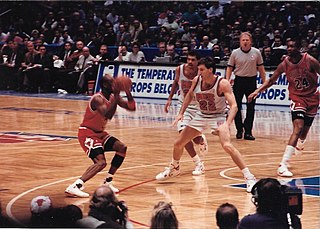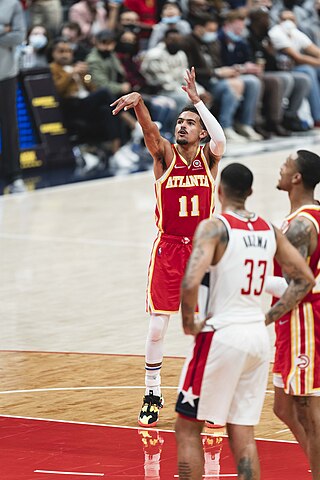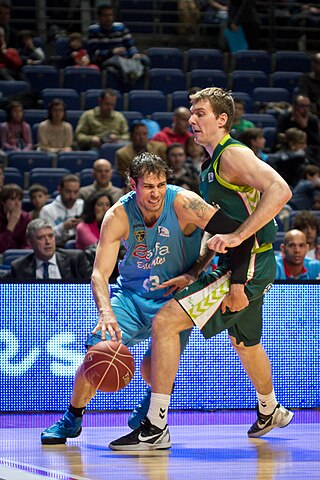Related Research Articles

Basketball is a team sport in which two teams, most commonly of five players each, opposing one another on a rectangular court, compete with the primary objective of shooting a basketball through the defender's hoop, while preventing the opposing team from shooting through their own hoop. A field goal is worth two points, unless made from behind the three-point line, when it is worth three. After a foul, timed play stops and the player fouled or designated to shoot a technical foul is given one, two or three one-point free throws. The team with the most points at the end of the game wins, but if regulation play expires with the score tied, an additional period of play (overtime) is mandated.

Women's basketball is the team sport of basketball played by women. It was first played in 1892, one year after men's basketball, at Smith College in Massachusetts. It spread across the United States, in large parts via women's college competitions, and has since spread globally. As of 2020, basketball is one of the most popular and fastest growing sports in the world.

In basketball, the basketball court is the playing surface, consisting of a rectangular floor, with baskets at each end. Indoor basketball courts are almost always made of polished wood, usually maple, with 3.048 meters (10 ft)-high rims on each basket. Outdoor surfaces are generally made from standard paving materials such as concrete or asphalt. International competitions may use glass basketball courts.

A shot clock is a countdown timer used in a variety of games and sports, proving a set amount of time that a team may possess the object of play before attempting to score a goal. Shot clocks are used in several sports including basketball, water polo, lacrosse, poker, ringette, korfball, tennis, ten-pin bowling, and various cue sports. It is analogous with the play clock used in American and Canadian football, and the pitch clock used in baseball. This article deals chiefly with the shot clock used in basketball.

In basketball, free throws or foul shots are unopposed attempts to score points by shooting from behind the free-throw line, a line situated at the end of the restricted area. Free throws are generally awarded after a foul on the shooter by the opposing team, analogous to penalty shots in other team sports. Free throws are also awarded in other situations, including technical fouls, and when the fouling team has entered the bonus/penalty situation. Also, depending on the situation, a player may be awarded between one and three free throws. Each successful free throw is worth one point.

In basketball, a personal foul is a breach of the rules that concerns illegal personal contact with an opponent. It is the most common type of foul in basketball. A player fouls out on reaching a limit on personal fouls for the game and is disqualified from participation in the remainder of the game.

The rules of basketball are the rules and regulations that govern the play, officiating, equipment and procedures of basketball. While many of the basic rules are uniform throughout the world, variations do exist. Most leagues or governing bodies in North America, the most important of which are the National Basketball Association and NCAA, formulate their own rules. In addition, the Technical Commission of the International Basketball Federation (FIBA) determines rules for international play; most leagues outside North America use the complete FIBA ruleset.

Goaltending is a violation of the rules in the sport of basketball. It consists of certain forms of player interference with the ball while it is on its way to the basket. It is goaltending if a player touches the ball when it is (a) in downward flight; or (b) above the basket rim and within an imaginary cylinder projecting above the rim; or (c) not touching the rim; or after it has touched the backboard and has a chance of going in the hoop.
In basketball, an illegal dribble occurs when a player ends their dribble by catching or causing the ball to come to rest in one or both hands and then dribbles it again with one hand or when a player touches it before the ball hits the ground. The dribble also ends when the dribbler palms/carries the ball by allowing it to come to rest in one or both hands. This is a palming/carrying the ball violation if the player continues with another dribble.
In basketball, traveling is a violation that occurs when a player takes too many steps without dribbling the ball. Traveling is also called, predominantly in a streetball game, "walking" or "steps". If the pivot foot is lifted, a pass or try for made basket must be made before the pivot foot is replaced to the floor.

This glossary of basketball terms is a list of definitions of terms used in the game of basketball. Like any other major sport, basketball features its own extensive vocabulary of unique words and phrases used by players, coaches, sports journalists, commentators, and fans.
In basketball, the five-second rule, or five-second violation, is a rule that helps promote continuous play. There are multiple situations where a five-second violation may occur.
Delay of game is an action in a sports game in which a player or team deliberately stalls the game, usually with the intention of using the delay to its advantage. In some sports, the delay of game is considered an infraction if it is longer than that permitted according to the game's rules, in which case a penalty can be issued. Some sports that have a delay of game penalty are American football, Canadian football, ice hockey and association football.

The key, officially referred to as the free throw lane by the National Basketball Association (NBA), the National Collegiate Athletic Association (NCAA), the National Association of Intercollegiate Athletics (NAIA), and the National Federation of State High School Associations (NFHS), and the restricted area by the International Basketball Federation (FIBA), is a marked area on a basketball court surrounding the basket, where much of the game's action takes place.

Basketball began with its invention in 1891 in Springfield, Massachusetts, by Canadian physical education instructor James Naismith as a less injury-prone sport than football. Naismith was a 31-year old graduate student when he created the indoor sport to keep athletes indoors during the winters. The game became established fairly quickly and grew very popular as the 20th century progressed, first in America and then in other parts of the world. After basketball became established in American colleges, the professional game followed. The American National Basketball Association (NBA), established in 1946, grew to a multibillion-dollar enterprise by the end of the century, and basketball became an integral part of American culture.
The 1981–82 NCAA Division I men's basketball season began on November 27, 1981, progressed through the regular season and conference tournaments, and concluded with the 1982 NCAA Division I men's basketball tournament championship game on March 29, 1982, at the Louisiana Superdome in New Orleans, Louisiana. The North Carolina Tar Heels won their second NCAA national championship with a 63–62 victory over the Georgetown Hoyas.
Basketball is a ball game and team sport in which two teams of five players try to score points by throwing or "shooting" a ball through the top of a basketball hoop while following a set of rules. Since being developed by James Naismith as a non-contact game that almost anyone can play, basketball has undergone many different rule variations, eventually evolving into the NBA-style game known today. Basketball is one of the most popular and widely viewed sports in the world.
Basketball is a team sport in which two teams of five players try to score points by throwing or "shooting" a ball through the top of a basketball hoop while following a set of rules. Basketball is one of the most popular and widely viewed sports in the world.

3x3 basketball is a variation of basketball played three-a-side, with one backboard and in a half-court setup. According to an ESSEC Business School study commissioned by the International Olympic Committee, 3x3 is the largest urban team sport in the world. This basketball game format is currently being promoted and structured by FIBA, the sport's governing body. Its primary competition is an annual FIBA 3X3 World Tour, comprising a series of Masters and one Final tournament, and awarding six-figure prize money in US dollars. The FIBA 3x3 World Cups for men and women are the highest tournaments for national 3x3 teams. The 3x3 format has been adopted for both the 2020 Summer Olympics and 2022 Commonwealth Games.

Big3 is a 3-on-3 basketball league founded by hip-hop musician and actor Ice Cube and entertainment executive Jeff Kwatinetz. The league consists of 12 teams whose rosters include both former NBA players and international players. The rules of Big3 games contain deviations from the official rules of 3-on-3 basketball as administered by FIBA. In January 2020, Big3 announced its rule set would be the core of a new basketball variant called "Fireball3".
References
- ↑ 2009-2011 Men's & Women's Basketball Rules Archived 2012-08-06 at the Wayback Machine Rule 4, Section 5, Article 2. Retrieved July 27, 2010
- ↑ NBA Official Rules (2009-2010) Archived 2012-01-11 at the Wayback Machine Rule 11, Section I, a, b, f, and h. Retrieved July 27, 2010
- ↑ 2009-2011 Men's & Women's Basketball Case Book A.R. 224. Retrieved July 27, 2010
- ↑ NBA Officials Media Guide Archived 2012-01-11 at the Wayback Machine 2009-2010 NBA Casebook. Question 164. Retrieved July 27, 2010
- ↑ NBA Official Rules (2009-2010) Archived 2012-01-11 at the Wayback Machine Rule 11, Section I, a. EXCEPTION. Retrieved July 27, 2010
- ↑ 2009-2011 Men's & Women's Basketball Rules Archived 2012-08-06 at the Wayback Machine Rule 4, Section 5, Article 3. Retrieved July 27, 2010
- 1 2 NBA Official Rules (2009-2010) Archived 2012-01-11 at the Wayback Machine Rule 11, Section I, i. PENALTY Retrieved July 27, 2010
- ↑ 2009-2011 Men's & Women's Basketball Rules Archived 2012-08-06 at the Wayback Machine Rule 9, Section 17, Article 1. Retrieved July 27, 2010
- ↑ 2009–2011 Men's & Women's Basketball Rules Archived 2012-08-06 at the Wayback Machine Rule 9, Section 17, Article 3. Retrieved July 27, 2010
- ↑ 2009-2011 Men's & Women's Basketball Rules Archived 2012-08-06 at the Wayback Machine Rule 5, Section 1, Article 8. Retrieved July 27, 2010
- ↑ "FIBA Official Basketball Rules 2014" (PDF). FIBA.com. FIBA. Archived from the original (PDF) on July 29, 2014. Retrieved May 14, 2015.
